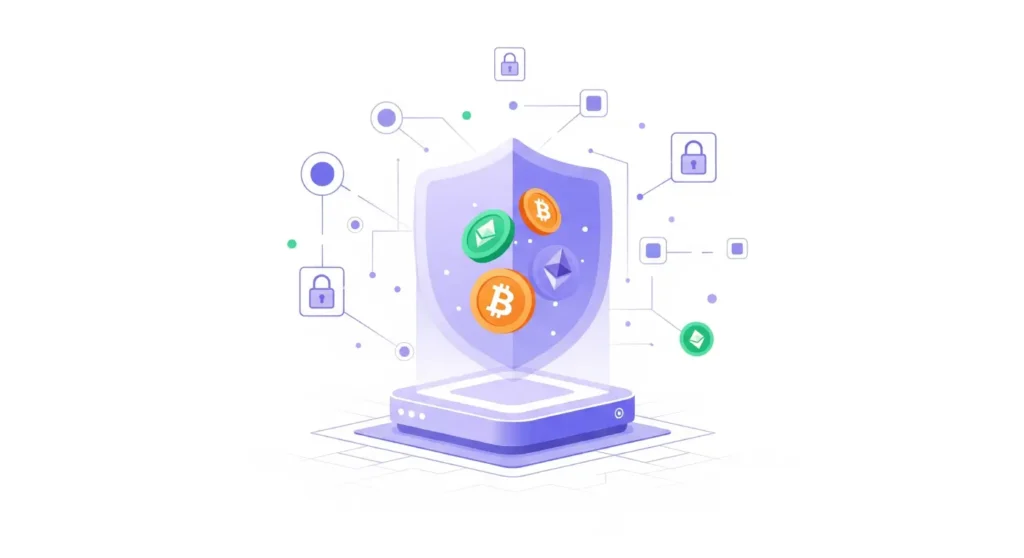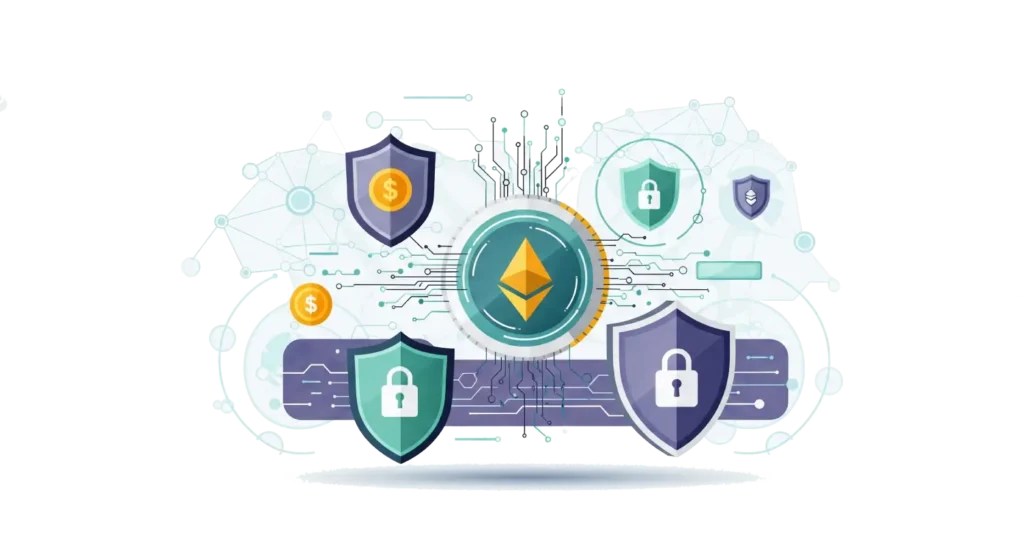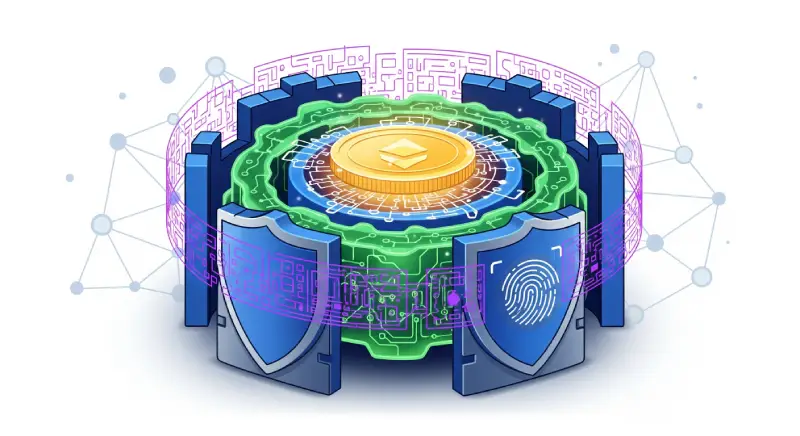
A personal blockchain server – your own full node (a program that stores and verifies the entire blockchain) – enhances the security of your crypto assets.
By running a crypto server, you verify transactions independently, safeguard your data, and strengthen the blockchain’s resilience. Whether you’re a trader using DeFi, a developer building dApps (apps running on blockchain), or a privacy advocate protecting financial data, a personal server reduces risks by minimizing reliance on middlemen.
This guide explains why a blockchain server is critical for crypto security, its benefits, and how to set it up.
Ready to secure your assets? Let’s dive into what a blockchain server is and how it boosts your crypto security! 🚀
📌 Key Takeaways
- ✅ Enhanced Security: A personal blockchain server reduces the risk of fraudulent transactions and reliance on third-party services, helping protect your assets from certain external threats.
- ✅ Strong Privacy: Running a full node helps reduce third-party tracking, although additional privacy measures may be needed for IP protection.
- ✅ Reliable Access: Reduces the risk of restrictions from third-party providers, ensuring stable access to DeFi and privacy tools.
- ✅ Advanced Features: Unlocks staking (earning rewards by locking crypto to support the network), smart contract deployment (programs that execute agreements on the blockchain), and custom RPC endpoints (connection points for wallets to interact with the blockchain).
- ✅ Bolstering Decentralization: Running your own full node helps decentralize and validate transactions, making it harder for centralized entities (e.g., governments or large mining pools) to control or censor the network.
- ✅ Future-Ready: Prepare for Web3 and IoT with a secure node.
- ✅ Best for: Traders, developers, and privacy advocates seeking secure, independent crypto management.
1. What Is a Personal Blockchain Server?
A personal blockchain server is like your own crypto library 📚, storing and verifying the entire blockchain history without relying on anyone else’s system, protecting your data and transactions.
It’s a device—your computer, a Raspberry Pi (a compact device the size of a credit card, designed for low-cost server tasks), or a dedicated machine—running a full node for a cryptocurrency network like Ethereum or Monero.
Unlike lightweight wallets (software wallets that rely on third-party nodes), a full node independently validates transactions and blocks, safeguarding your assets. This aligns with the peer-to-peer design of decentralized crypto networks, where users connect directly without intermediaries.
What does a personal blockchain server do? 🚀
- Verifies transactions: Confirms every block and transaction without external services, protecting against fraud. ✅
- Stores blockchain data: Holds the full history (~500GB for some blockchains, 2TB+ for Ethereum in 2025). 💾
- Acts as a private hub: Powers wallets, DeFi apps, or smart contracts securely. 🔗
Popular options include 🌟
- Bitcoin Full Node: Software like Bitcoin Core for secure transaction validation. 🔒
- Ethereum Node: Geth or Nethermind for smart contracts and staking. ⚙️
- Monero Node: Monero CLI for privacy-focused transactions. 🕵️
- Multi-chain solutions: Umbrel or DAppNode (software with a simple interface for setting up nodes on multiple blockchains) for easy setup across blockchains, beginner-friendly. 🌐
Comparison of Blockchain Servers 📊
| Blockchain | Software | Storage (2025) | Ease of Setup | Use Case |
|---|---|---|---|---|
| Crypto | Bitcoin Core | ~500GB (pruned: ~550MB) | Moderate | Privacy, trading |
| Ethereum | Geth/Nethermind | ~2TB (pruned: ~500GB) | Advanced | Developers, stakers |
| Monero | Monero CLI | ~200GB | Moderate | Privacy advocates |
| Multi-chain | Umbrel/DAppNode | Varies (~500GB–2TB) | Beginner-friendly | All users |
2. Key Benefits of Your Own Crypto Server
A personal blockchain server safeguards your crypto assets while strengthening decentralized networks. From robust privacy to advanced functionality, here’s why a crypto server is valuable. 🚀
2.1. Enhanced Security & Privacy 🔒
Third-party nodes can log your wallet addresses and IP, risking data leaks or surveillance. A personal server ensures your crypto assets stay secure:
- No tracking: Your node connects directly to the blockchain, hiding your data. Monero nodes, for example, obscure transaction details entirely for enhanced privacy. 🕵️
- Censorship resistance: In 2022, third-party providers blocked privacy tool nodes under regulatory pressure. Your node ensures reliable access to DeFi or privacy tools. 🛡️
- Secure key management: Store sensitive files (e.g., wallet.dat or keystore, files holding your crypto keys) locally to protect against hacks. 🔐
Keep in mind that security also depends on protecting the device itself and using strong access controls.
2.2. Bolstering Decentralization 💪
The strength of crypto lies in its peer-to-peer network of independent nodes, enhancing network security. Your server contributes to this:
- Network durability: More nodes make blockchains harder to censor, protecting against centralized attacks, as seen in China’s 2021 crypto crackdown. 🌍
- Community impact: By validating transactions, you counter centralization from large mining pools, securing the network. 🤝
Note that not all full nodes are validators or miners—their main role is to independently verify and propagate blockchain data, helping maintain network security and decentralization.
2.3. Cost Efficiency & Customization 💸
Third-party node providers charge for premium access or impose rate limits. A personal server saves money and offers flexibility:
- Zero fees: Avoid subscription costs for blockchain access, saving money. 💰
However, operating your own node involves hardware costs, electricity consumption, and technical maintenance. - Custom settings: Use pruning (removing old blockchain data to save space, e.g., setting prune=550 to reduce storage to ~550MB) or prioritize transactions for faster processing. ⚙️
- Scalable setups: Start with a Raspberry Pi (~$100 in 2025) or scale to a dedicated server for robust operation. 🖥️
2.4. Advanced Features & Flexibility 🚀
A blockchain server unlocks capabilities beyond lightweight wallets:
- Run validators: Participate in staking (locking crypto to support the network) for ~3–5% annual yield (2025 estimate) on Ethereum’s Beacon Chain. 💸
Be aware that staking often requires meeting minimum hardware and asset thresholds (e.g., 32 ETH for Ethereum). - Deploy smart contracts: Build and test dApps from your node. 📝
- Custom RPC endpoints: Connect software wallets to your node for direct blockchain access, avoiding third-party outages. 🔗
- Testnet experimentation: Practice on testnets (practice blockchains with no real money) risk-free. 🧪
3. How to Set Up Your Own Blockchain Server
Setting up a personal blockchain server is a straightforward way to secure your crypto experience. By running a full node, you gain independence from third-party providers and unlock the full potential of networks like Ethereum or Monero. Here’s a step-by-step guide tailored for beginners and seasoned users. 🛠️
Step 1: Choose Your Hardware 🖥️
Your server’s hardware determines performance and security:
- Crypto Full Node: 2+ CPU cores, 8GB RAM, 500GB+ SSD (1TB recommended). 💾
- Ethereum Node: 4+ CPU cores, 16GB+ RAM, 2TB+ SSD (or 500GB with pruning). ⚙️
- Budget Option: Raspberry Pi (~$100–150 in 2025, a compact device the size of a credit card for low-cost server tasks) for lightweight chains like Stellar (a blockchain for fast, low-cost transactions). 💸
- Pro Tip: Use an SSD for faster sync; HDDs are too slow for large blockchains. 🚀
Step 2: Select Your Software 📦
Choose software matching your blockchain and skill level for a secure setup:
- Crypto: Bitcoin Core (~500GB in 2025). 🔒
- Ethereum: Geth or Nethermind for smart contracts and staking. ⚙️
- Monero: Monero CLI for privacy-focused transactions. 🕵️
- Plug-and-Play: Umbrel or DAppNode (software with a simple interface for setting up nodes) for easy, beginner-friendly multi-chain setups. 🌐
- Testnet Option: Start with a testnet node (a practice blockchain with no real money) to learn risk-free. 🧪
Step 3: Sync the Blockchain ⏳
Syncing downloads the blockchain’s history securely:
- Initial Sync: Some blockchains take ~1–3 days; Ethereum ~1–7 days (use Geth’s “snap sync,” a faster syncing method). ⏱️
- Internet: A stable 50 Mbps+ connection speeds up syncing. 📡
- Ports: Open 8333 or 30303 (Ethereum) on your firewall for secure connections. 🔐
- Snapshots: Use pre-synced snapshots (pre-downloaded blockchain data) from trusted sources to save time. 🚀
Step 4: Secure and Maintain Your Node 🔒
Keep your server safe to protect your crypto assets:
- Updates: Regularly update software to patch vulnerabilities. 🛠️
- Backups: Encrypt wallet.dat or keystore files (holding your crypto keys) offline for maximum security. 💾
- Security: Use a VPN or Tor; restrict inbound connections to prevent attacks. 🕵️
- Monitoring: Use Grafana or Umbrel’s dashboard to check node health. 📊
- Pruning: Enable pruning (e.g., set prune=550 to reduce storage to ~550MB) to save disk space securely. ⚙️
4. Potential Challenges (and Solutions)
Running a personal blockchain server is empowering but comes with hurdles. Here’s how to tackle common challenges to ensure a secure crypto server experience. 🛠️
4.1. High Storage Requirements 💾
Challenge: Some blockchains need ~500GB, Ethereum archive nodes 2TB+ (2025).
- Enable pruning (e.g., set prune=550 to reduce storage to ~550MB) to save space. ⚙️
- Upgrade to a 1TB SSD or 4TB (Ethereum) for secure storage. 💾
- Use lighter chains like Stellar (~50GB, a blockchain for fast transactions) on a Raspberry Pi. 🖥️
4.2. Slow Blockchain Sync ⏳
Challenge: Syncing can take days or weeks (Ethereum).
- Use Geth’s “snap sync” (~1–2 days) or trusted snapshots (pre-downloaded data) for faster syncing. 🚀
- Ensure a 50 Mbps+ internet connection. 📡
- Opt for pre-synced nodes via DAppNode for simplicity. 🌐
4.3. Energy and Hardware Costs ⚡️
Challenge: 24/7 nodes increase electricity and hardware costs.
- Use a Raspberry Pi (~$100 in 2025) for low-power setups. 💸
- Rent a VPS (~$20/month in 2025, a virtual private server in the cloud) for secure hosting. ☁️
- Schedule syncs during off-peak hours to save energy. ⏱️
4.4. Technical Complexity 🛠️
Challenge: Configuring nodes can intimidate non-tech users.
- Use Umbrel or DAppNode for simple, beginner-friendly interfaces. 🌐
- Follow community tutorials for step-by-step guidance. 📚
- Practice on a testnet node for risk-free learning. 🧪
4.5. Security Risks 🔐
Challenge: Poorly secured nodes risk data exposure.
- Restrict ports to prevent unauthorized access. 🛡️
- Encrypt and back up wallet files offline for maximum protection. 💾
- Monitor with Grafana for secure operation. 📊
Pro Tip: Start with a testnet node or Umbrel for a low-risk introduction.
5. The Future of Personal Blockchain Servers
As Web3 (the new internet powered by blockchain) evolves, personal blockchain servers will become key to crypto security. Here’s what’s coming for full node operators. 🚀
5.1. Powering Web3 and IoT 🌐
Nodes will integrate with IoT (Internet of Things, where devices like smartwatches use crypto) for secure transactions:
- Microtransactions: Pay for utilities in crypto via your node, like smart devices paying for electricity. 💸
- dApps: Serve as private gateways for decentralized platforms. 🔗
- Cross-chain: Support blockchains like Polkadot via Umbrel for broader compatibility. 🌍
5.2.Decentralized Governance 🤝
Nodes will support DAO (Decentralized Autonomous Organization, a group managed by code and votes) operations:
- Voting: Validate DAO proposals, ensuring fair governance. ✅
- Community networks: Host niche blockchains with enhanced security. 🌐
- Resilience: Strengthen crypto networks against centralized threats. 💪
5.3. Secure Wallet Connections 🔒
Your node can enhance wallet security by allowing direct blockchain connections:
- Private RPC: Connect software wallets to your node for direct blockchain access, reducing reliance on third-party services. 🔗
- Privacy: Use Monero nodes for anonymous transactions. 🕵️
- Offline signing: Sign transactions offline (without internet) to prevent hacks. 🛡️
5.4. Mass Adoption 🚀
Nodes will become user-friendly:
- Tools: DAppNode simplifies setups for beginners. 🌐
- Hardware: Affordable devices support multi-chain nodes. 🖥️
- Cloud: Hybrid local-cloud solutions, like VPS (virtual private servers), for reliable operation. ☁️
What’s Next? By 2030, nodes could be as common as Wi-Fi routers, offering robust security. Start with a testnet node today! 💪
6. Frequently Asked Questions
Below, we answer common questions to demystify running a personal blockchain server for crypto security.
Q1: ❓ What’s the Difference Between a Full Node and a Lightweight Wallet?
A: A full node (e.g., Bitcoin Core) validates the entire blockchain, ensuring secure transactions. Lightweight wallets (e.g., software wallets) rely on third-party nodes, risking tracking. A crypto server offers stronger privacy and security.
Q2: 💸 How Much Does It Cost to Run a Node?
A: Costs vary (estimates for 2025):
- Budget: Raspberry Pi (~$100) + 1TB SSD (~$80) for affordable setups. 🖥️
- Mid-range: PC with 2TB SSD (~$500–800) for secure storage. 💾
- Cloud: VPS (~$20/month, a virtual private server) for cloud-based nodes. ☁️
- Check Umbrel for affordable options. 🌐
Q3: 💻 Can I Run a Node on My Laptop?
A: Yes, but with limitations:
- Bitcoin: Possible with 8GB RAM and 500GB SSD (with pruning) for secure operation. 🔒
- Ethereum: Challenging; needs 16GB+ RAM, 2TB SSD for full nodes. ⚙️
- Best: Use a dedicated device or testnet for secure practice. 🧪
Q4: ⏳ How Long Does Syncing Take?
A: Sync times vary (2025 estimates):
- Bitcoin: ~1–3 days (50 Mbps+ internet) for secure syncing. 📡
- Ethereum: ~1–3 days (snap sync); longer for archive nodes. ⏱️
- Tip: Use snapshots from trusted sources for faster setup. 🚀
🎯 Conclusion
A personal blockchain server is a powerful tool to secure crypto assets, embodying the peer-to-peer vision of decentralized networks. By running a full node, you protect transactions, ensure strong privacy, and strengthen blockchains.
From reducing third-party risks to enabling staking or dApps, a crypto server keeps your assets safer. 🌍
Start small with a testnet node using Bitcoin Core or Umbrel. As Web3 grows, your node will keep your crypto secure.
Take control today—download your node software and join the decentralized movement! 🚀
Want to learn more about keeping your crypto safe? Check out this easy guide: How to Secure Crypto for Beginners.

